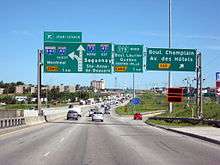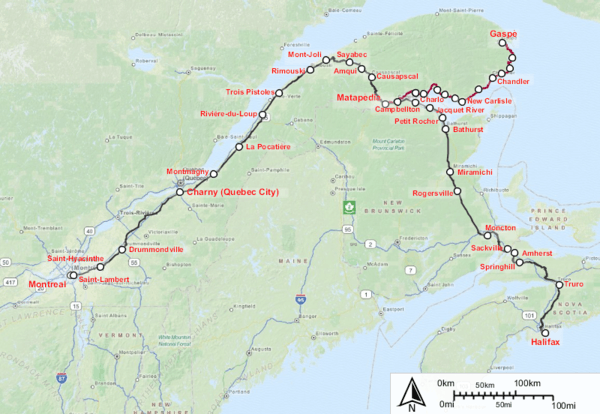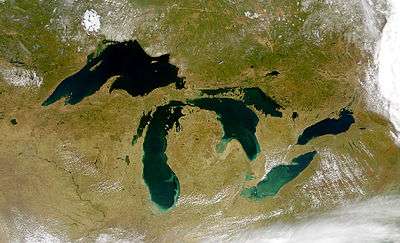Quebec City–Windsor Corridor
| Quebec City–Windsor Corridor | |
|---|---|
| Region | |
 | |
| Country |
|
| Province |
|
| Population (2011 est.) | |
| • Total | 18,420,000 |
| Time zone | EST (UTC−5) |
| • Summer (DST) | EDT (UTC−4) |
| Postal code prefixes | G, H, J, K, L, M, N |
| Area code(s) | 226, 289, 343, 365, 416, 418, 437, 438, 450, 514, 519, 579, 581, 613, 647, 705, 819, 873, 905 |
The Quebec City–Windsor Corridor is the most densely populated and heavily industrialized region of Canada. As its name suggests, the region extends between Quebec City in the northeast and Windsor, Ontario in the southwest, spanning 1,150 kilometres (710 mi). With more than 18 million people, it contains over half of the country's population and three of Canada's four largest metropolitan areas according to the 2011 Census. In its relative importance to Canada's economic and political infrastructure, it has many similarities to the Northeast megalopolis in the United States. The name was first popularized by Via Rail, which runs frequent passenger rail service in the Quebec City–Windsor Corridor in its service area known as "The Corridor".
Geography
The corridor extends from Quebec City, Quebec in the northeast to Windsor, Ontario in the southwest, running north of the Saint Lawrence River, Lake Ontario and Lake Erie. For most of its length, the corridor runs through a narrow strip of farmland with the Canadian Shield to the north and the Appalachian Mountains or the Great Lakes to the south. A drive of only a few minutes north from many of the corridor's cities or towns will show an abrupt change from flat farmland and limestone bedrock to the granite hills of the shield. The highways often run right on the boundary of the shield, and it is possible to observe the frequent change from limestone to granite in rockcuts along the way. There are, however, several wider areas of flat farmland, including the southwestern Ontario peninsula between Lake Huron and Lake Erie, the eastern Ontario delta from Ottawa to the junction of the Ottawa and St. Lawrence Rivers at Montreal, and the Eastern Townships southeast of Montreal. There is also a minor Great Lakes corridor of stratified limestone called the Niagara Escarpment.
Because of the moderating influence of the Great Lakes and the frequent influx of warm, moist air from the Gulf of Mexico, the corridor—particularly the western half—has a markedly warmer climate than the rest of central Canada. The rich soil and the warm climate mean that the flora and fauna in the corridor are similar to those in the deciduous forests of the eastern United States as far south as Virginia, rather than the evergreen boreal forest that covers most of central Canada up to the Arctic. The forest in southwestern Ontario is often referred to as Carolinian forest.
Population
According to the 2006 Canadian Census, more than 67% of Ontario's population lives in its portion of the corridor. Similarly, nearly half of Quebec's population lives in or close to Montreal and Quebec City. About half of Canada's total population live between Quebec City and Windsor.[1]
The three major census metropolitan areas (CMAs) in the Corridor are:
- Toronto-Mississauga-Brampton-Markham (5,583,064)
- Montreal-Laval (3,824,221)
- Ottawa-Gatineau (1,236,324)
The remaining census metropolitan areas along the corridor are:
- Quebec City-Lévis (765,706)
- Hamilton (721,053)
- Kitchener-Waterloo-Cambridge (477,160)
- London (474,786)
- St. Catharines-Niagara Falls (392,184)
- Oshawa (356,177)
- Windsor (319,246)
- Sherbrooke (201,890)
- Barrie (187,013)
- Kingston (159,561)
- Trois-Rivières (151,773)
- Brantford (135,501)
- Guelph (141,097)
- Peterborough (118,975)
Other significant urban areas along the corridor include: Belleville, Brockville, Chatham–Kent, Cornwall, and Sarnia.

Cities located in neighbouring American regions (such as Western New York and Southeast Michigan) are not considered part of the corridor but have many significant cultural, economic, and political ties with urban areas on or near the border such as the Detroit–Windsor area.
History
Early history
During the French colonization, this area of New France was named Canada and was a single administrative unit under the governor-general (with regional deputy governors in some cities). However, only the eastern third of the corridor, from Quebec City to Montreal, was heavily settled. The major cross-country route used by voyageurs in the fur trade continued west from Montreal through the Canadian Shield along the Ottawa Valley to Lake Nipissing and Georgian Bay, passing far to the north of what would later become the Ontario part of the corridor. The lack of good farmland made that route unsuitable for settlement, however, and the frequent portages made transportation in boats larger than canoes difficult.
American Revolutionary War
When the English-speaking United Empire Loyalists arrived in Canada after the American Revolution, they naturally settled along the narrow strip north of the St. Lawrence River and lower Great Lakes, where good farm land was available and larger boats could be used for transportation, and these people formed the English-speaking nucleus of what would later be Ontario (by contrast, many of the Ontario towns along the old fur-trading and logging route to the north, through the Ottawa Valley and westward, still have significant French-speaking populations). Initially, Kingston was the principal city of the English half of the corridor, but eventually Toronto outgrew it.
Colonial Canada
During both the North American part of the Seven Years' War between Great Britain and France and the War of 1812 between United Kingdom and the United States, settlements along the corridor were at the centre of the conflicts. Ottawa was eventually chosen as Canada's capital by Queen Victoria precisely because it was further inland and thus less vulnerable to attack, though it is now also considered part of the corridor. The Rideau Canal was constructed to provide a way to bypass the most vulnerable part of the corridor, from Cornwall to Kingston, where it lies directly on the U.S. border.
Canada
The construction of the Saint Lawrence Seaway during the late 1950s made it possible for some ocean-going vessels to travel the full length of the corridor and beyond to the upper Great Lakes, but resulted in the destruction of several villages in the Eastern Ontario portion of the corridor.
Transportation

The corridor is held together by a series of major transportation routes—water, road, rail, and air—all running close together and sometimes overlapping each other. These routes are anchored by Ontario Highway 401, the busiest highway in North America[2] from Windsor leading into Quebec Autoroute 20 to Montreal and Quebec City.
Waterways
The oldest transportation route is the St. Lawrence River and Great Lakes, where the series of channels and locks that make up the St. Lawrence Seaway allow ocean-going vessels and lake freighters to travel the entire length of the corridor.
Roadways

The Ontario portion of the corridor was originally joined by Highway 2 (often known locally by names such as "Montreal Road," "Toronto Road," "Dundas Street," or "Kingston Road") following the routes of older stagecoach roads and the paths and trails that predated them. Highway 2 still forms the main street of many of the corridor's Ontario towns and cities (which were built around it), but large parts of the highway are now maintained by counties or municipalities rather than the province. From 1938 to 1968 the province of Ontario built Highway 401, a freeway that bypasses most of the town and city centres. Highway 401 is now the main transportation route of the corridor up to the Quebec border, where it becomes Autoroute 20 and continues east through the Quebec part of the corridor to Quebec City.
Rail

Both the Canadian National Railway (CN) and the Canadian Pacific Railway (CP) have extensive freight railway lines along the length of the Quebec City – Windsor Corridor. Intercity passenger railway service is provided by Via Rail throughout the region, mostly using CN freight lines. Referred to in Via Rail's published timetables as simply the Corridor, the Quebec City – Windsor Corridor is the busiest portion of the Via system, accounting for the majority of Canada's intercity passenger trains and ridership. About 67% of Via Rail's total revenue is earned on the Quebec City – Windsor Corridor.
Other inter-city trains from outside the region originate and terminate at cities in the Corridor, such as Via's Canadian, Montreal – Gaspé train and Ocean. Amtrak offers two international inter-city passenger railway lines that starts in New York City with one that ends in Toronto and the other in Montreal, serving cities along the Corridor as well as in Upstate New York.
Prior to Via's formation in 1978, both CN and CP operated Corridor services. Proposals have been advanced to build a high-speed rail link in this corridor. On November 14, 2011, the governments of Ontario, Quebec and Canada have officially released the final report of a high-speed rail study for this corridor.[3]
Airports
_091.jpg)
The major passenger airports along the corridor are Toronto Pearson International Airport (ranked 20th globally for international passenger traffic and 18th for aircraft traffic), Montréal-Pierre Elliott Trudeau International Airport, Ottawa Macdonald-Cartier International Airport, Québec/Jean Lesage International Airport, Hamilton/John C. Munro International Airport (ranked second in Canada for cargo traffic) and the military airbase at CFB Trenton. There are roughly 108 flights between Montreal, Ottawa and Toronto every work day, making it the busiest air route in Canada and 15th busiest air route in the world.
Other civilian corridor airports with scheduled airline service include Windsor Airport, Sarnia (Chris Hadfield) Airport, London International Airport, Region of Waterloo International Airport, Billy Bishop Toronto City Airport, Kingston/Norman Rogers Airport, Lake Simcoe Regional Airport and Gatineau-Ottawa Executive Airport. Montréal-Mirabel International Airport is a large facility near Montreal that is mainly used for cargo flights but is also home to medical evacuation[4] and general aviation[5][6] flights.
Inside the corridor, the busiest area of travel is the Toronto–Ottawa–Montreal triangle. Air Canada serves the three cities with its Rapidair service, offering hourly flights, and its principal competitor WestJet offers similar service. Air Canada and Porter Airlines fly from Billy Bishop Toronto City Airport to Ottawa and Montreal, while Air Canada Jazz offers commuter flights connecting many of the smaller airports to Toronto, Ottawa, and Montreal. In addition to scheduled air service, some of the airports along the corridor also have frequent charter flights like Air Transat and Sunwing to popular tourist destinations.
See also
| Wikivoyage has a travel guide for Windsor-Quebec corridor. |
References
- ↑ "2006 Census analysis series". 2.statcan.ca. 2009-10-13. Retrieved 2009-11-20.
- ↑ Alphabet City | Fuel - Features - The Post-Carbon Highway
- ↑ High-Speed Passenger Rail Study
- ↑ It's liftoff for AirMédic ambulance Archived May 11, 2011, at the Wayback Machine.
- ↑ Mirabel redécolle Archived September 30, 2008, at the Wayback Machine.
- ↑ Canada Flight Supplement. Effective 0901Z 15 September 2016 to 0901Z 10 November 2016
Coordinates: 44°20′N 77°05′W / 44.34°N 77.08°W
